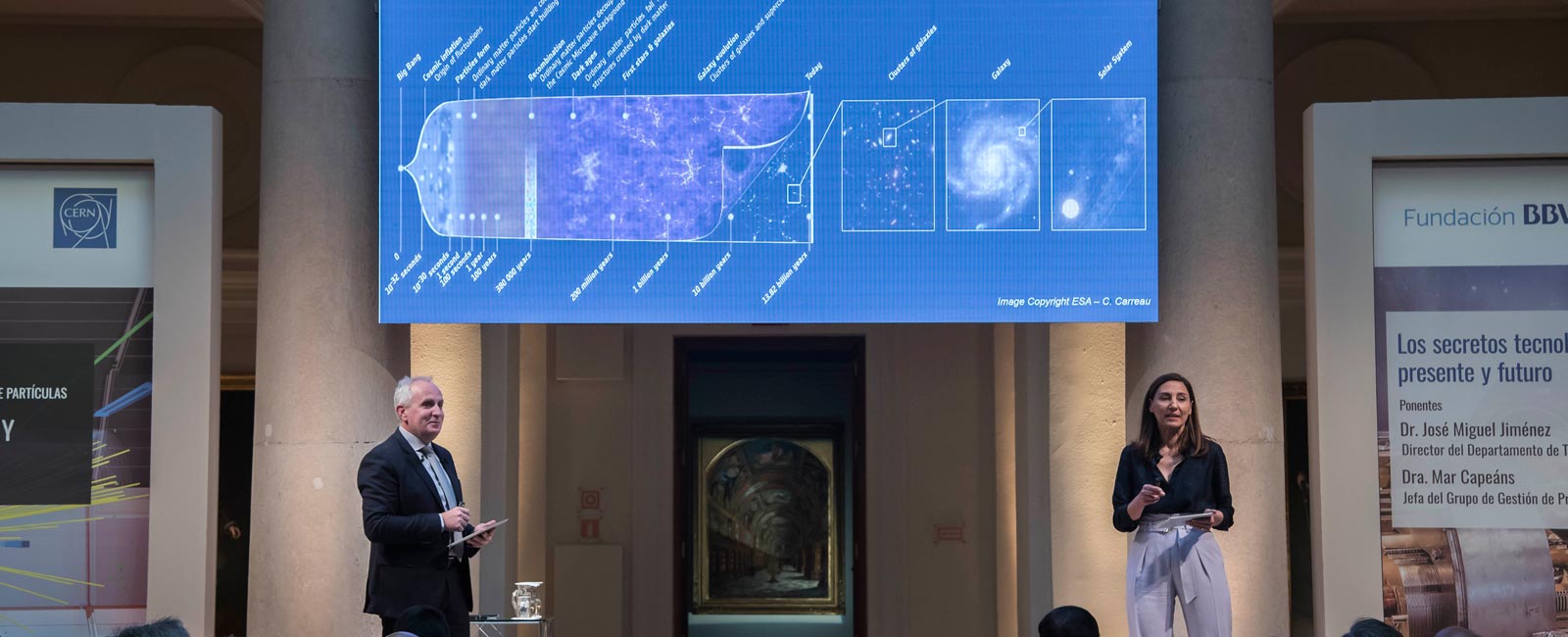
CERN visits the BBVA Foundation to present the technologies of tomorrow’s physics that will lead the hunt for dark matter
The largest particle accelerator in action worldwide, the LHC at CERN, near Geneva, has just entered its last year of operation before what the physicists call the Long Shutdown 2 (LS2 for short), a technical stoppage lasting several years to upgrade the machine. Meantime, work proceeds on analyzing the reams of data gathered in the last two years, amid which may lie some key that unlocks the great enigmas, like the nature of dark matter, or even something altogether new to physics. Against this backdrop, CERN physicists Mar Capeáns, Projects and Planning Group Leader in the Technology Department, and José Miguel Jiménez, the department’s director, were in the BBVA Foundation on May 17 to give the opening talk in the latest edition of the particle physics lecture series co-organized by CERN and the BBVA Foundation.
21 May, 2018
This will be the 4th edition of a series initiated in 2014 which seeks to inform the non-specialist public about the discoveries made at CERN, and familiarize them with the more technological aspects of particle physics research. Under the title “The Technological, Globalized Dimension of Science,” this new set of lectures will focus on the technological challenges associated with the large scientific infrastructures of the future, including preliminary studies on CERN after the LHC.
Following the start-up at the end of last April of the current round of LHC operation, the feeling is “really good. We remain alert to any new results coming out of the LHC, while we focus on preparing the large-scale technical stoppage of 2019-2020,” relate Mar Capeáns and José Miguel Jiménez. “The priority is to keep the LHC running smoothly to maximize the amount of data we can collect before the two-year stoppage. There will be no energy upgrades [with respect to previous years]; the goal is to gather date under identical physical conditions.”
In its first run, in 2012, the LHC obtained what is its most important result to date: the detection of the Higgs boson, the particle that explains the mass of all others. The Higgs was eagerly awaited because it was the only one of the particles predicted by the Standard Model that had still failed to make an appearance. The Standard Model provides the best explanation at the time of writing for the functioning of the three fundamental forces we perceive in our daily lives: electromagnetism, the weak nuclear force and the strong nuclear force. What is does not tell us, however, is how to integrate gravity with these three forces. Nor can it explain the content of the 95 percent of the universe made up of dark matter and dark energy, both of an unknown nature.
It is for this reason that in Run 2 of the great particle accelerator, physicists are looking out for clues as to what lies beyond the Standard Model. This second period of operations began in 2016 – after a first major technical stoppage – and concludes at the end of this year.
The LHC has gathered vast quantities of data in these past two years, but without announcing anything spectacular. However there is reason still to hope: “There are still no clear indications of new results, but nor have the team ruled out discoveries showing up in their detailed analyses of all the Run 2 data,” explain Capeáns and Jiménez.
The need for “breakthrough technologies”
Their lecture, on 17 May, was titled “The Technological Secrets of Particle Physics: Present and Future.” In it they explained “the vigorous R&D plan promoted by CERN, through collaborations worldwide, to explore future options in accelerator technologies, ultra-fast and compact detectors, and powerful computer systems.”
Because, as Capeáns and Jiménez insist, optimizing existing technological solutions is no longer enough to respond to the challenges and big open questions of particle physics: “In the future, we will need a new concept of accelerators capable of even higher energy levels. We are not for the strategy of continually enlarging accelerators using traditional, industrialized technologies. CERN would rather pursue new, breakthrough technologies that are not only more advanced but can also bring new perspectives to bear with a major socioeconomic impact.”
“Consolidating and optimizing existing technologies could boost the performance of the LHC by a factor of 2 to 3, when we have set our sights on something a lot higher!” the speakers continue.
The demands are similar in the case of the detectors. And laboratories in CERN member states and collaborating countries are already at work, developing “new sensor and electronics concepts. This is an ineludible challenge as we all need to invest in R&D and innovation so as not to miss out on future opportunities,” Capeáns and Jiménez concur.
The next instalments of this edition of the CERN-BBVA Foundation lecture series on particle physics will feature Marzio Nessi, Neutrino Platform Project Leader at CERN and Lucio Rossi, the laboratory’s High Luminosity LHC (HL-LHC) Project Leader.
